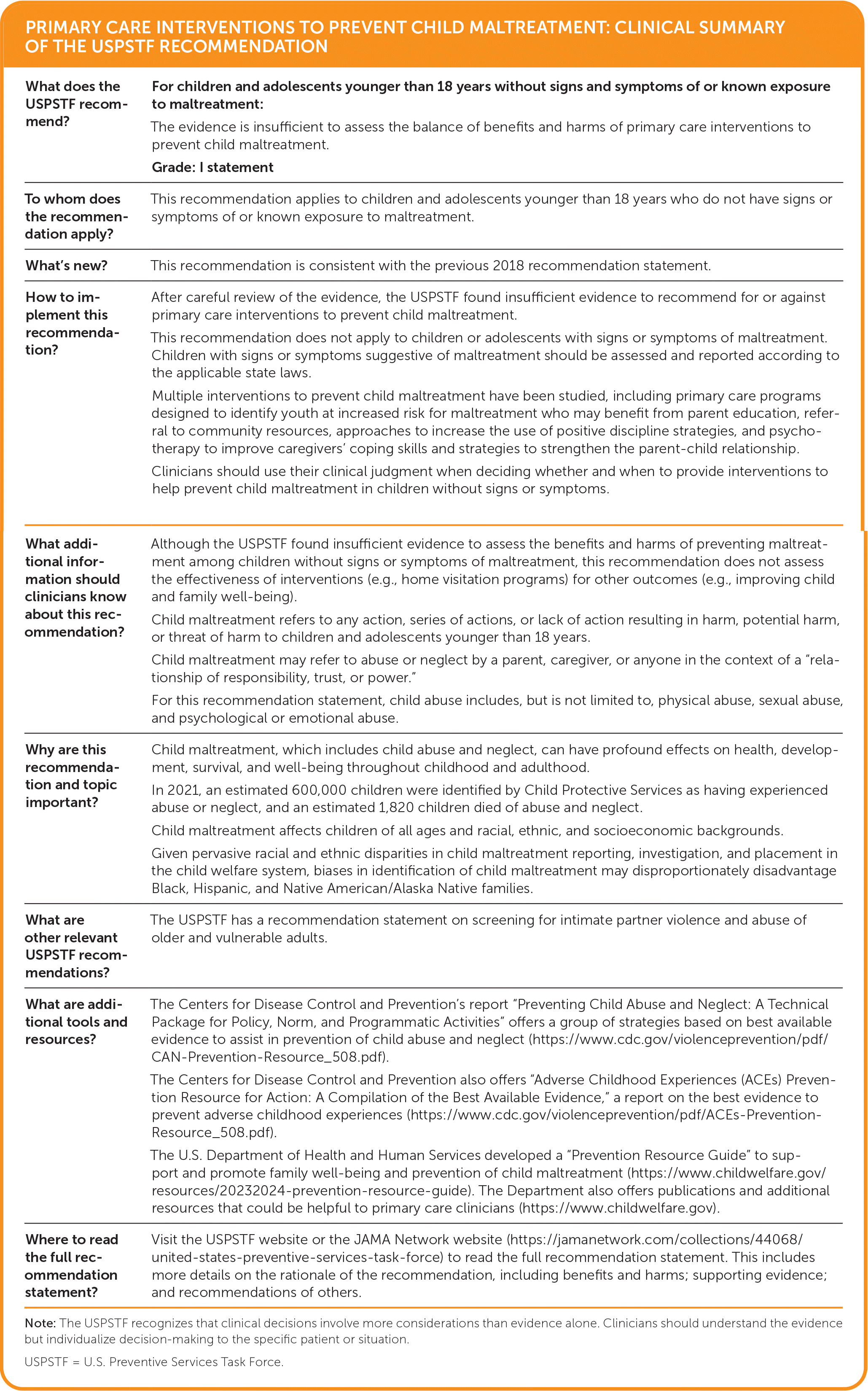
Am Fam Physician. 2024;109(6):online
As published by the USPSTF.

| What does the USPSTF recommend? | For children and adolescents younger than 18 years without signs and symptoms of or known exposure to maltreatment: The evidence is insufficient to assess the balance of benefits and harms of primary care interventions to prevent child maltreatment. Grade: I statement |
| To whom does the recommendation apply? | This recommendation applies to children and adolescents younger than 18 years who do not have signs or symptoms of or known exposure to maltreatment. |
| What's new? | This recommendation is consistent with the previous 2018 recommendation statement. |
| How to implement this recommendation? | After careful review of the evidence, the USPSTF found insufficient evidence to recommend for or against primary care interventions to prevent child maltreatment. This recommendation does not apply to children or adolescents with signs or symptoms of maltreatment. Children with signs or symptoms suggestive of maltreatment should be assessed and reported according to the applicable state laws. Multiple interventions to prevent child maltreatment have been studied, including primary care programs designed to identify youth at increased risk for maltreatment who may benefit from parent education, referral to community resources, approaches to increase the use of positive discipline strategies, and psychotherapy to improve caregivers' coping skills and strategies to strengthen the parent-child relationship. Clinicians should use their clinical judgment when deciding whether and when to provide interventions to help prevent child maltreatment in children without signs or symptoms. |
| What additional information should clinicians know about this recommendation? | Although the USPSTF found insufficient evidence to assess the benefits and harms of preventing maltreatment among children without signs or symptoms of maltreatment, this recommendation does not assess the effectiveness of interventions (e.g., home visitation programs) for other outcomes (e.g., improving child and family well-being). Child maltreatment refers to any action, series of actions, or lack of action resulting in harm, potential harm, or threat of harm to children and adolescents younger than 18 years. Child maltreatment may refer to abuse or neglect by a parent, caregiver, or anyone in the context of a “relationship of responsibility, trust, or power.” For this recommendation statement, child abuse includes, but is not limited to, physical abuse, sexual abuse, and psychological or emotional abuse. |
| Why are this recommendation and topic important? | Child maltreatment, which includes child abuse and neglect, can have profound effects on health, development, survival, and well-being throughout childhood and adulthood. In 2021, an estimated 600,000 children were identified by Child Protective Services as having experienced abuse or neglect, and an estimated 1,820 children died of abuse and neglect. Child maltreatment affects children of all ages and racial, ethnic, and socioeconomic backgrounds. Given pervasive racial and ethnic disparities in child maltreatment reporting, investigation, and placement in the child welfare system, biases in identification of child maltreatment may disproportionately disadvantage Black, Hispanic, and Native American/Alaska Native families. |
| What are other relevant USPSTF recommendations? | The USPSTF has a recommendation statement on screening for intimate partner violence and abuse of older and vulnerable adults. |
| What are additional tools and resources? | The Centers for Disease Control and Prevention's report “Preventing Child Abuse and Neglect: A Technical Package for Policy, Norm, and Programmatic Activities” offers a group of strategies based on best available evidence to assist in prevention of child abuse and neglect (https://www.cdc.gov/violenceprevention/pdf/CAN-Prevention-Resource_508.pdf). The Centers for Disease Control and Prevention also offers “Adverse Childhood Experiences (ACEs) Prevention Resource for Action: A Compilation of the Best Available Evidence,” a report on the best evidence to prevent adverse childhood experiences (https://www.cdc.gov/violenceprevention/pdf/ACEs-Prevention-Resource_508.pdf). The U.S. Department of Health and Human Services developed a “Prevention Resource Guide” to support and promote family well-being and prevention of child maltreatment (https://www.childwelfare.gov/resources/20232024-prevention-resource-guide). The Department also offers publications and additional resources that could be helpful to primary care clinicians (https://www.childwelfare.gov). |
| Where to read the full recommendation statement? | Visit the USPSTF website or the JAMA Network website (https://jamanetwork.com/collections/44068/united-states-preventive-services-task-force) to read the full recommendation statement. This includes more details on the rationale of the recommendation, including benefits and harms; supporting evidence; and recommendations of others. |
The full recommendation statement is available at https://www.uspreventiveservicestaskforce.org/uspstf/recommendation/child-maltreatment-primary-care-interventions.
The USPSTF recommendations are independent of the U.S. government. They do not represent the views of the Agency for Healthcare Research and Quality, the U.S. Department of Health and Human Services, or the U.S. Public Health Service.

